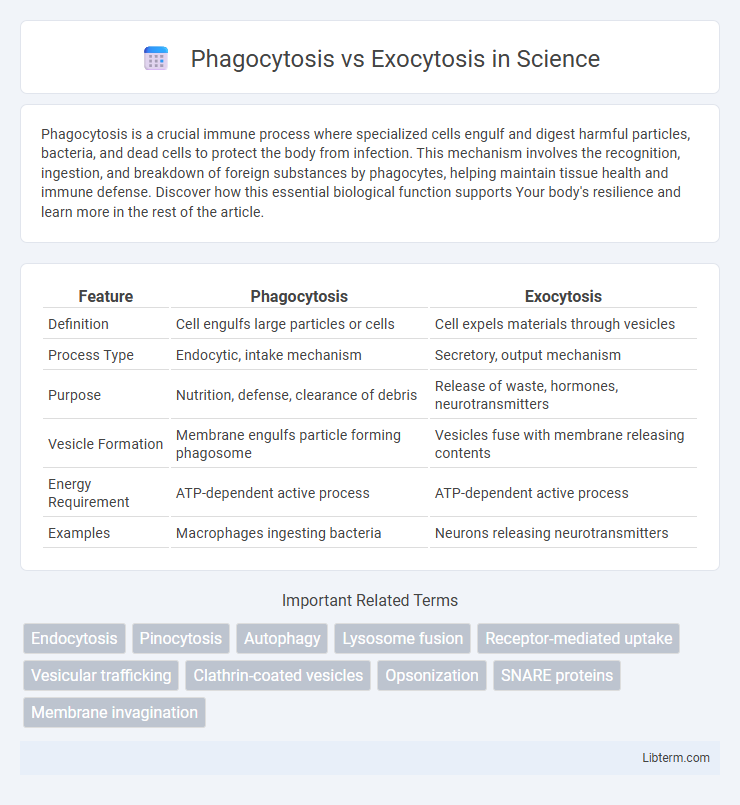Phagocytosis is a crucial immune process where specialized cells engulf and digest harmful particles, bacteria, and dead cells to protect the body from infection. This mechanism involves the recognition, ingestion, and breakdown of foreign substances by phagocytes, helping maintain tissue health and immune defense. Discover how this essential biological function supports Your body's resilience and learn more in the rest of the article.
Table of Comparison
| Feature | Phagocytosis | Exocytosis |
|---|---|---|
| Definition | Cell engulfs large particles or cells | Cell expels materials through vesicles |
| Process Type | Endocytic, intake mechanism | Secretory, output mechanism |
| Purpose | Nutrition, defense, clearance of debris | Release of waste, hormones, neurotransmitters |
| Vesicle Formation | Membrane engulfs particle forming phagosome | Vesicles fuse with membrane releasing contents |
| Energy Requirement | ATP-dependent active process | ATP-dependent active process |
| Examples | Macrophages ingesting bacteria | Neurons releasing neurotransmitters |
Introduction to Phagocytosis and Exocytosis
Phagocytosis is a cellular process where cells engulf large particles, such as pathogens or debris, by wrapping their membrane around the target to form a phagosome. Exocytosis involves the fusion of intracellular vesicles with the plasma membrane to release contents, such as neurotransmitters or waste materials, outside the cell. Both mechanisms are essential for cellular homeostasis, immune response, and intercellular communication.
Defining Phagocytosis: The Cell’s Ingestion Mechanism
Phagocytosis is a cellular process where cells engulf large particles such as pathogens or debris by enclosing them in a membrane-bound vesicle called a phagosome. This mechanism is crucial for immune defense and cellular cleanup, allowing cells like macrophages to ingest harmful bacteria effectively. In contrast, exocytosis involves vesicles fusing with the plasma membrane to expel materials from the cell, highlighting fundamentally opposite roles in cellular transport.
Understanding Exocytosis: The Cell’s Secretion Process
Exocytosis is a vital cellular process where vesicles containing molecules such as hormones, neurotransmitters, or waste products fuse with the plasma membrane to release their contents outside the cell. This mechanism is essential for maintaining cellular communication, regulating the extracellular environment, and expelling harmful substances. In contrast to phagocytosis, which involves engulfing external particles, exocytosis facilitates active secretion and membrane recycling, ensuring proper cell function and homeostasis.
Core Differences Between Phagocytosis and Exocytosis
Phagocytosis is a cellular process involving the engulfment of large particles or microorganisms into the cell for digestion, predominantly seen in immune cells like macrophages. Exocytosis, in contrast, is the mechanism by which cells expel materials such as waste products or signaling molecules by vesicle fusion with the plasma membrane. The core difference lies in phagocytosis being an intake process of external substances, whereas exocytosis is an export process releasing intracellular materials.
Biological Importance of Phagocytosis
Phagocytosis plays a crucial role in the immune system by enabling macrophages and neutrophils to engulf and destroy pathogens, thereby preventing infections. It facilitates the clearance of cellular debris and apoptotic cells, maintaining tissue homeostasis and promoting healing. This process is essential for innate immunity and the activation of adaptive immune responses.
Physiological Roles of Exocytosis
Exocytosis plays a crucial physiological role in the secretion of hormones, neurotransmitters, and enzymes, facilitating intercellular communication and metabolic regulation. It is essential for maintaining cellular homeostasis by removing waste products and incorporating membrane proteins and lipids into the plasma membrane. This process enables immune cells to release signaling molecules, thereby orchestrating inflammatory responses and defending against pathogens.
Cellular Machinery Involved in Both Processes
Phagocytosis involves the reorganization of actin filaments to form pseudopods that engulf large particles into phagosomes, relying heavily on membrane receptors and cytoskeletal components like actin and myosin. Exocytosis depends on the coordinated action of SNARE proteins, motor proteins such as kinesin and dynein, and the cytoskeleton to transport and fuse secretory vesicles with the plasma membrane, facilitating cargo release. Both processes require precise regulation of intracellular signaling pathways and vesicle trafficking machinery to maintain cellular homeostasis and communication.
Phagocytosis vs Exocytosis in Immune Response
Phagocytosis and exocytosis play crucial roles in the immune response by managing cellular material exchange and pathogen elimination. Phagocytosis enables immune cells like macrophages and neutrophils to engulf and digest harmful pathogens and debris, directly eliminating threats. Exocytosis facilitates the release of signaling molecules, such as cytokines and antibodies, from immune cells to coordinate and amplify the immune system's response to infection.
Impacts on Health and Disease
Phagocytosis and exocytosis play critical roles in immune defense and cellular homeostasis, impacting health by regulating pathogen clearance and waste removal. Dysregulation of phagocytosis contributes to chronic infections, autoimmune disorders, and neurodegenerative diseases, while impaired exocytosis affects hormone secretion, neurotransmitter release, and can lead to metabolic and neurological conditions. Understanding the balance between these processes is essential for developing treatments targeting infectious diseases, inflammation, and cellular dysfunction.
Conclusion: Comparing and Contrasting Cellular Transport Mechanisms
Phagocytosis engulfs large particles or pathogens via membrane invagination, while exocytosis expels materials such as waste or proteins through vesicle fusion with the plasma membrane. Both processes are energy-dependent and crucial for maintaining cellular homeostasis, yet phagocytosis serves primarily in defense and nutrient acquisition, whereas exocytosis is essential for secretion and membrane recycling. Understanding these distinct yet complementary transport mechanisms highlights their roles in cellular communication and immune response efficiency.
Phagocytosis Infographic

 libterm.com
libterm.com